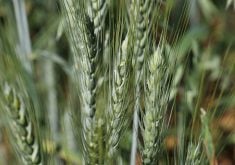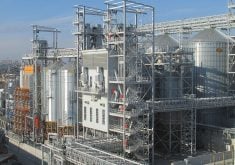Farmers who produce a bumper harvest of a particular crop that depresses the price traditionally reduce acreage the following year and grow something else.
And so American farmers will likely grow less corn in 2015 after producing a record large crop in 2014.
Several forecasters think seeded corn area will be around 88 million acres, down from 90.9 million last spring.
The likely alternatives are soybeans and wheat, but the market doesn’t need more soybeans and wheat.
The world has increased its productive capacity. For example, the U.S. has put Conservation Reserve Program land back into crop production.
Read Also

Flax sector sees omega-3 opportunity
SASKATOON — A global shortage of omega-3 oils could be an opportunity for the flax sector, says an industry official….
The area planted with the four major U.S. crops — corn, soybeans, wheat and cotton — totalled slightly more than 225 million acres 10 years ago. Last year, the area was almost 243 million, up about eight percent. Production is also up in South America, Russia and Ukraine.
The crop shortages of a few years ago are over. Supplies are ample.
And yet analytical firm Informa Economics forecasts that American farmers will do something that they have never done before: seed more soybeans than corn.
Informa’s current outlook is for a record 88.78 million acres of soybeans, up from 84.2 million acres.
Informa also projected 2015 U.S. winter wheat acreage at 42.278 million, down from 42.399 million the previous crop.
On Jan. 12, the U.S. Department of Agriculture will release its first forecast for 2015 U.S. winter wheat acres.
The soybean number is troubling because of its potential to weigh down prices of all oilseeds, including canola. Soybean prices have performed better than expected since harvest, with strong demand for the beans and meal dragging soybean back up to around US$10.30 per bushel from the seasonal low of about $9.20 set at the end of September
However, several analysts warn that there will be a sharp decline in soybeans once the South American harvest begins.
AgResource analyst Bill Tierney said in November that 2014-15 soybean prices in the March futures contract would likely drop to $8.50 per bu. if South America’s crop is as big as expected.
Tierney said soybean prices will be less than $7 a tonne next harvest if the expectation of record U.S. soybean acreage holds and there is a normal production season.
Informa executive vice-president Rob Westmoreland said soybeans could be $8.50 in fall.
Darin Newsom, who is more bullish on corn than other analysts but is more bearish on soybeans, said new crop soy could fall as low as $6 a bu. as the 2015-16 year-end stocks-to-use ratio climbs to a burdensome 20 percent.
A price of $6 is down about 40 percent from the price in December.
Newsom shocked farmers about this time last year when he forecast that corn prices could fall to as low as $2 per bu. Luckily, he was wrong.
However, if Newsom is correct this time and if the decline in soybeans fully washes into canola, then we would be looking at a canola futures price of around $265, or about $6 per bu., which is a frightening prospect.
Canola has not been below $300 since 2006.
When this column was written in mid-December, the November 2015 ICE Futures contract was trading at about $430, or about $9.75 per bu.
Even if you went with Westmoreland’s less dramatic decline in soybean prices to $8.50, it would imply a canola price of around $376 a tonne. That is still about $20 worse than the lowest price point this past fall.
There is no guarantee any of these early forecasts will be correct.
The weather in South America has been favourable for production and the developing El Nino would tend to support a good moisture trend, but things could go wrong — maybe too much rain at harvest?
U.S. acreage might not increase as much as expected or there could be weather problems.
Still, from this position early in the crop planning season, these soybean price forecasts are sobering and point to the need for price risk management.














